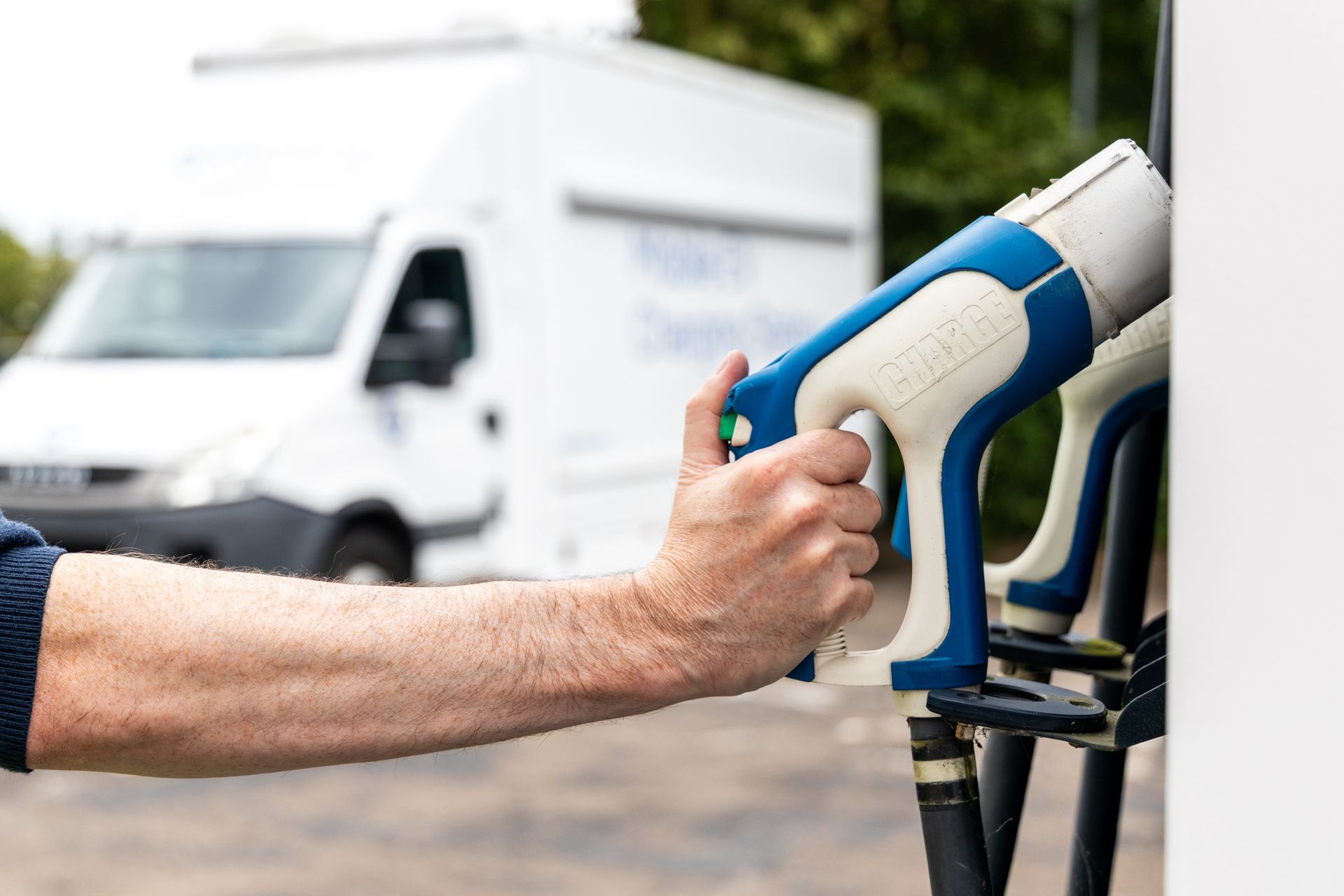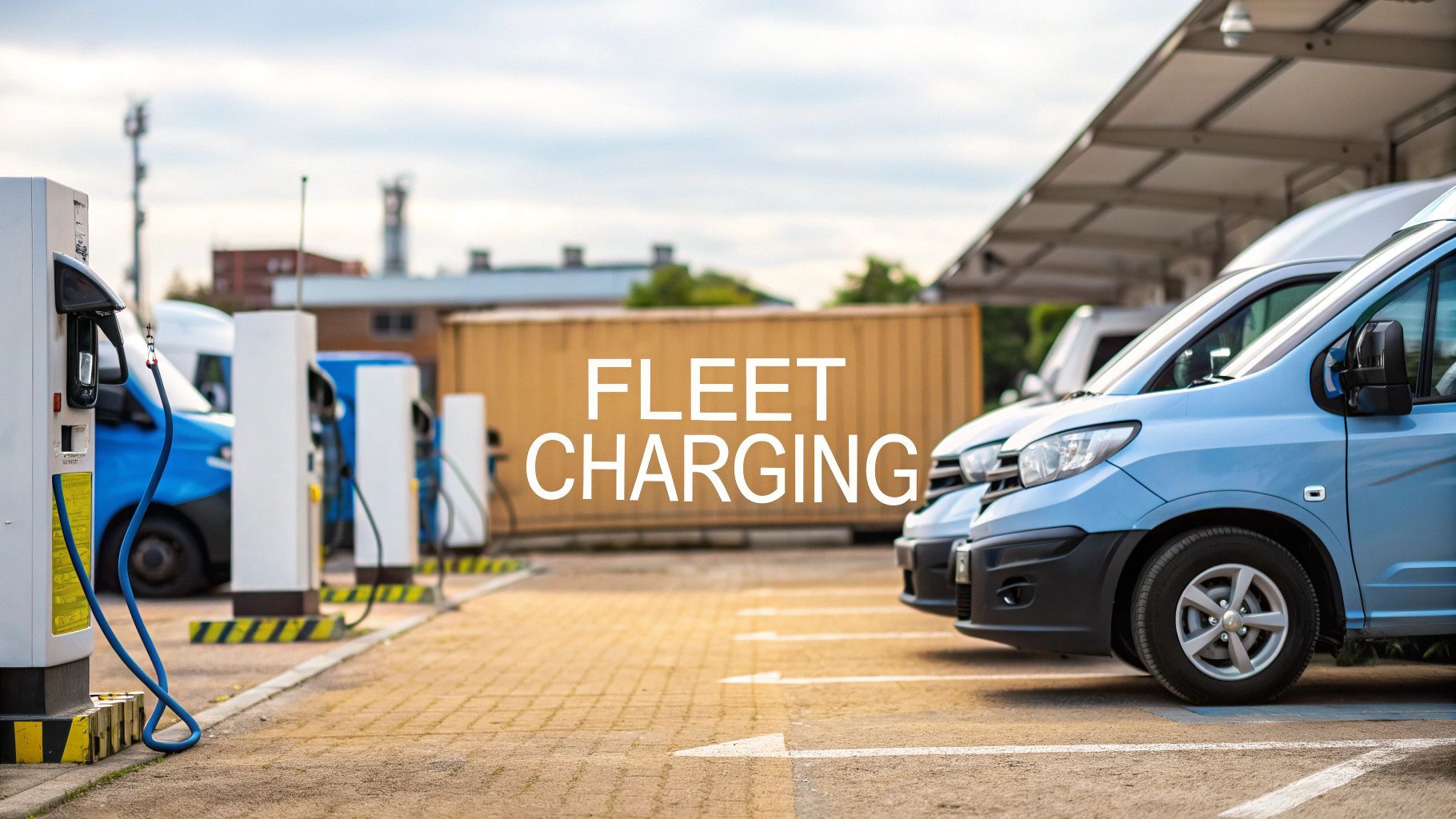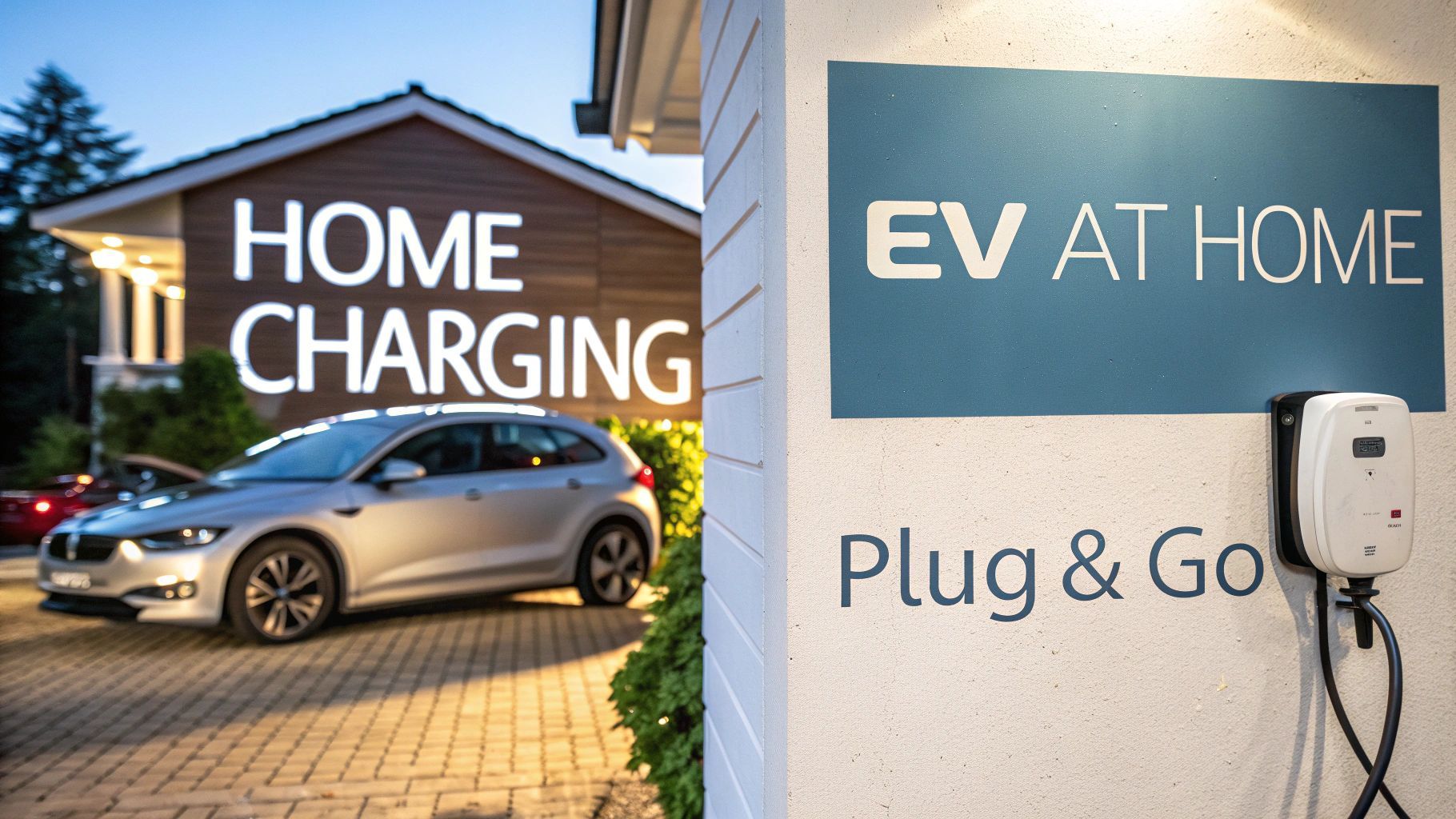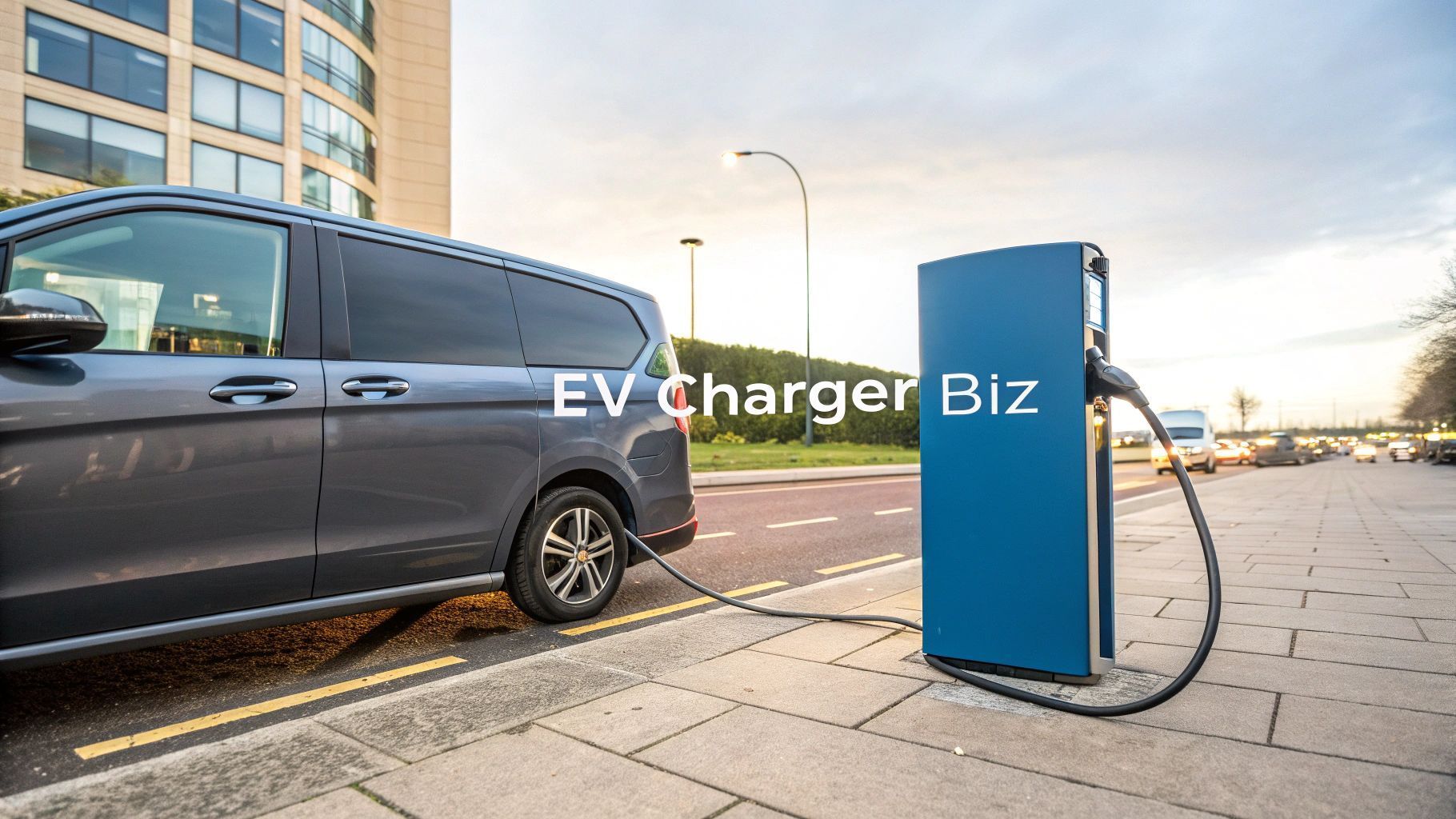Unpacking Electric Vehicle Maintenance Costs
When people talk about switching to an electric car, the conversation often turns to how much cheaper they are to run. It's a massive selling point and for good reason—drivers can save more than 50% on servicing in the first few years alone.
This isn't just marketing spin. The savings are real and they stem from one simple fact: electric vehicles are mechanically much simpler than their petrol or diesel counterparts. Fewer moving parts means fewer things to break, replace or service.
Unpacking the Real Cost of Maintaining an Electric Vehicle
While the initial purchase price of an EV gets a lot of attention, it's the long-term running costs that really tell the story of value. Think about a traditional car engine for a moment—it's a complex beast with hundreds of moving parts, all needing regular checks, fluids and replacements.
An EV motor, by contrast, is refreshingly simple. This fundamental difference means you can wave goodbye to a whole list of common maintenance jobs. There are no oil changes to schedule, no spark plugs to replace and no exhaust systems to rust through and fail. Just by removing these recurring expenses, you’re already saving a significant amount of money and hassle.
How EVs Save You Money
One of the biggest, yet often overlooked, savings comes from your brakes. EVs use a clever system called regenerative braking . When you lift your foot off the accelerator, the electric motor essentially works in reverse, slowing the car down and sending a little bit of energy back into the battery.
Because the motor is doing a lot of the braking work, your actual brake pads and discs get a much easier life. They're used less often and far less aggressively, which means they last a whole lot longer than on a petrol car.
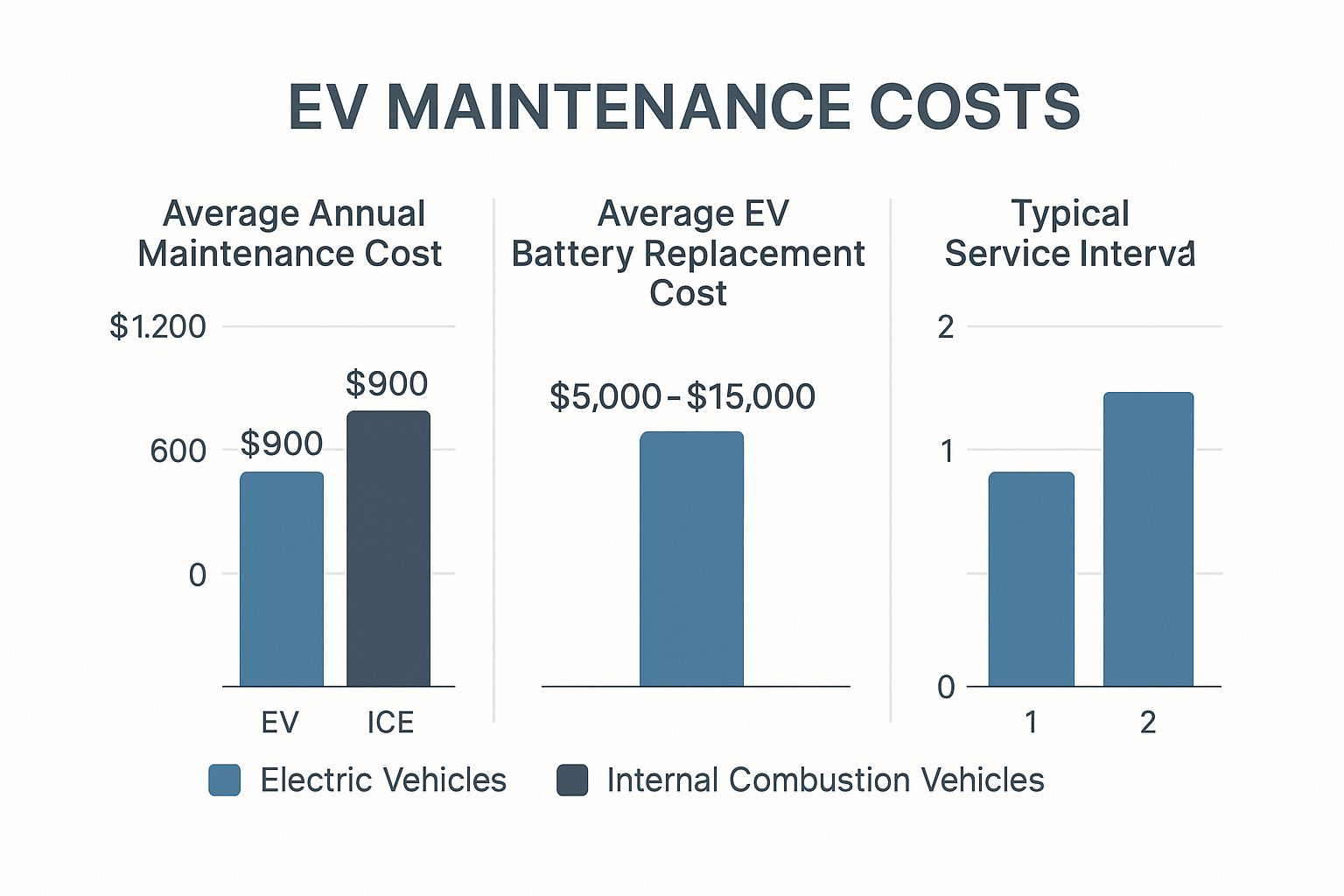
This simple table really brings the savings into focus.
EV vs Petrol Vehicle Maintenance Costs at a Glance (5-Year Estimate)
Here’s a straightforward comparison of what you might expect to spend on typical maintenance over five years of ownership in the UK.
| Maintenance Category | Electric Vehicle (EV) | Petrol Vehicle (ICE) |
|---|---|---|
| Routine Servicing | £400 - £600 | £1,000 - £1,500 |
| Brake Pads & Discs | £200 - £300 | £500 - £800 |
| Tyres | £300 - £500 | £300 - £500 |
| Coolant & Fluid Checks | £100 - £150 | £200 - £300 |
| Oil Changes & Filters | £0 | £500 - £700 |
| Exhaust System Maintenance | £0 | £300 - £600 |
| Estimated 5-Year Total | £1,000 - £1,550 | £2,800 - £4,400 |
As you can see, the numbers speak for themselves. While a petrol car could easily set you back £3,000 to £4,000 over five years, an EV owner is likely looking at a bill closer to £1,000 to £1,500 for the same period. It's a consistent, predictable saving that makes a huge difference to the total cost of ownership.
By eliminating many of the routine tasks required for petrol and diesel cars, electric vehicles not only reduce costs but also minimise the time your car spends in the garage. This convenience is a key part of what makes the EV ownership experience so appealing.
It’s this kind of practical benefit that drives our mission forward and understanding these advantages is central to seeing how ZAPME is enhancing the EV ownership experience with flexible, on-demand charging solutions.
Why Servicing an EV Costs Less
The massive drop you see in electric vehicle maintenance costs isn't some small quirk; it’s baked right into the engineering. Think about the difference between a complex, ticking mechanical watch with hundreds of tiny, interlocking gears and a simple, powerful fan with just one moving part. That's the core difference between a traditional internal combustion engine (ICE) and an electric motor.
The beautiful simplicity of an EV's powertrain is where the real savings kick in. A petrol or diesel engine is basically a symphony of controlled explosions, needing a huge network of parts just to keep running. An electric motor, on the other hand, gets the car moving using electromagnetism with far fewer components, creating a much more direct and efficient system.
Eliminating Common Maintenance Headaches
So much of what you pay for during a traditional car service simply doesn't exist in an electric vehicle. And we’re not talking about minor bits and pieces. These are some of the most common and costly recurring expenses that petrol car owners have just come to accept as normal. The difference is stark when you see what’s missing from the equation.
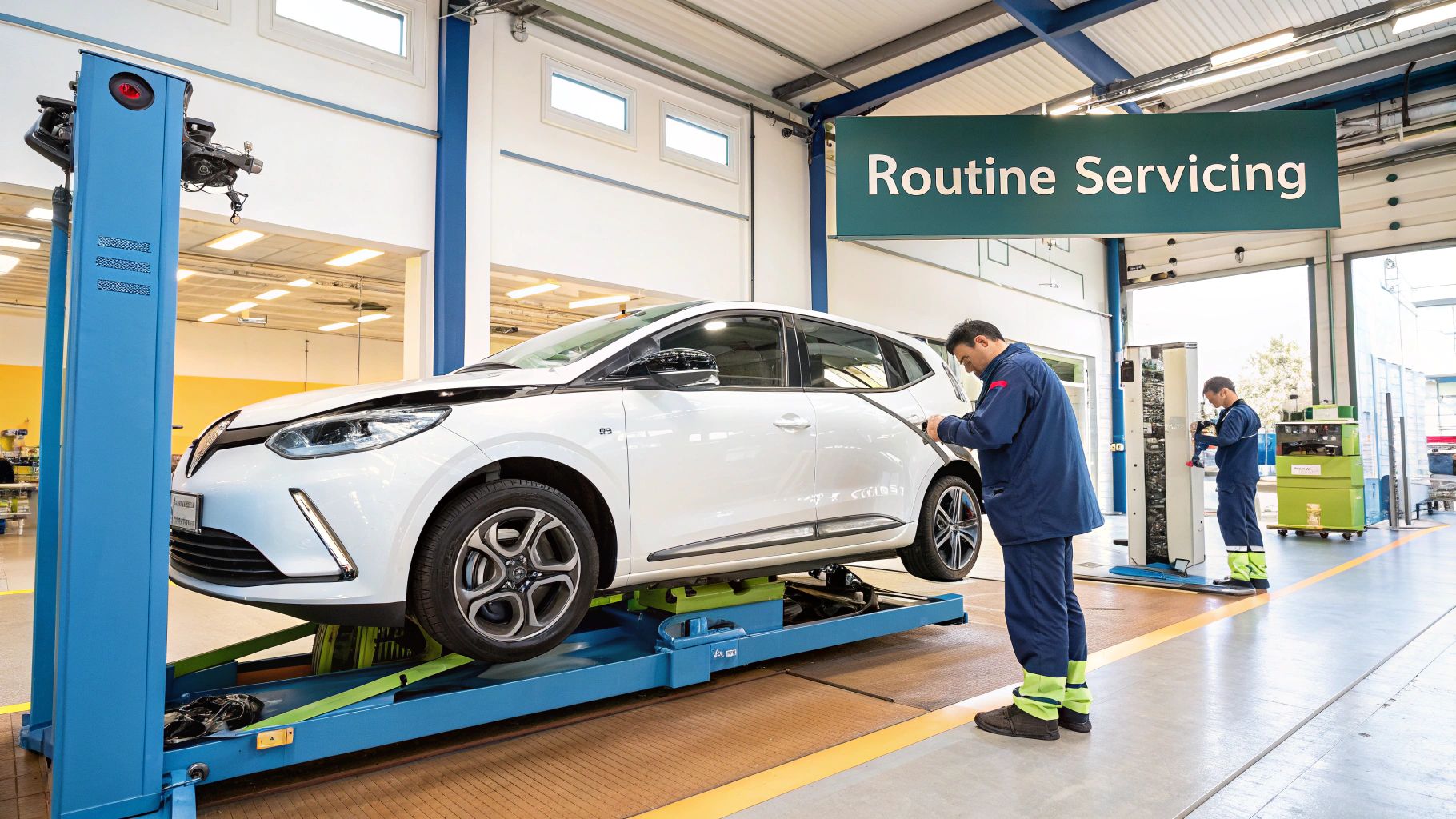
A typical EV has absolutely no need for the following, instantly wiping them off your maintenance budget:
- Engine Oil and Filters: With no pistons or cylinders creating friction, there's nothing to lubricate. That means no more messy, expensive oil changes. Ever.
- Spark Plugs: Electric motors don't use combustion so there are no spark plugs to wear out and replace.
- Exhaust Systems: Without exhaust fumes, there are no catalytic converters, silencers or pipes to rust, crack and eventually fail.
- Clutches and Complex Gearboxes: Most EVs use a simple single-speed transmission, getting rid of clutch fluid, plates and the risk of costly gearbox repairs.
- Timing Belts: That dreaded timing belt replacement—a major expense for ICE owners every 60,000 to 100,000 miles —is a problem you'll never have with an EV.
Every single one of these eliminated parts represents not just the cost of the component itself but also the labour bill for inspecting, maintaining and replacing it. Over an ownership period of five to ten years, those savings really stack up, easily running into thousands of pounds.
The Power of Regenerative Braking
It’s not just about the parts that are gone. One of an EV's cleverest features actively saves you money on the components that are still there: regenerative braking . This system completely changes how an electric car slows down.
When you lift your foot off the accelerator in an EV, the electric motor flips its function. Instead of using energy to turn the wheels, the wheels' momentum turns the motor, which now acts like a generator. This process creates resistance that slows the car down smoothly while sending a little bit of energy back into the battery.
This means that for much of your day-to-day driving, you aren't even using the traditional friction brakes. The motor does the bulk of the work, saving your brake pads and discs for when you really need to stop hard.
The practical benefit here is enormous. While a petrol car might need new brake pads and discs every 25,000 to 50,000 miles , an EV driver could easily go twice as long—or even longer—before needing a replacement. This one feature drastically reduces one of the most common running costs of any vehicle and it’s a key reason why EV maintenance bills are consistently lower.
A Detailed Breakdown of EV Maintenance Expenses
So, what are you actually paying for when you take an electric vehicle in for a service? While the big picture points to some serious savings, it’s worth digging into the specific jobs that keep your EV running smoothly. Once you move past the general comparisons, a closer look at a typical EV service schedule reveals a clear shift in focus—it’s all about safety checks and consumables, not complex mechanical repairs.
Even without an engine, certain routine inspections are non-negotiable for any vehicle's health and safety. These are the common-sense checks that ensure your car is roadworthy but without the long list of engine-related tasks, the whole process is usually quicker and a lot kinder on your wallet.
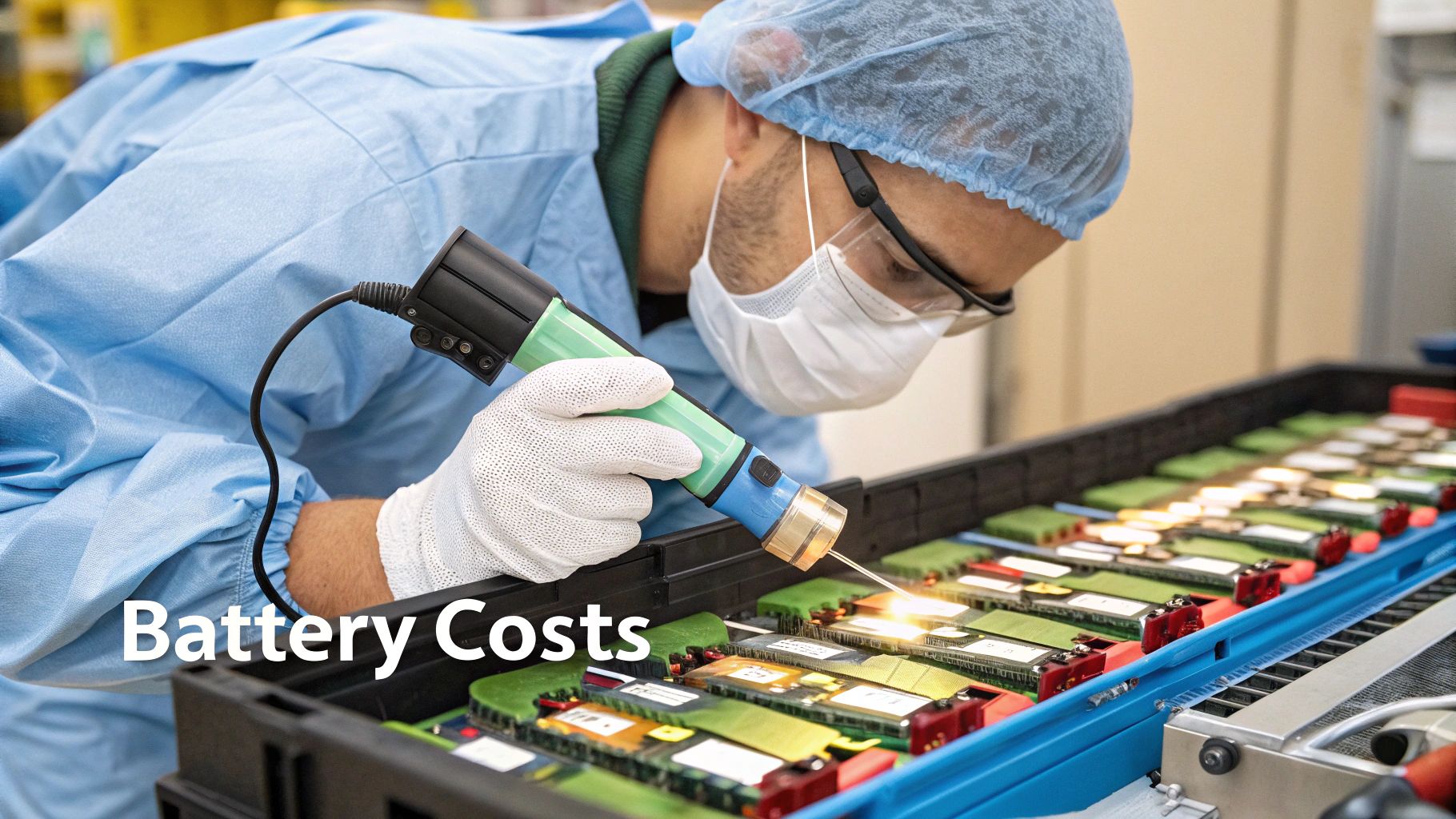
What a Typical EV Service Includes
When you drop your electric car off for its scheduled maintenance, the technician’s checklist looks quite different from one for a petrol or diesel car. The attention moves away from the engine bay and centres on the components that EVs and traditional cars share, plus a few electric-specific inspections.
A standard service appointment will almost always cover these key areas:
- Cabin Air Filter Replacement: This little filter keeps the air inside your car clean. Just like in any other vehicle, it needs replacing every year or two to stay effective.
- Brake Fluid Inspection: Although regenerative braking means your brake pads and discs get an easier life, the hydraulic fluid that powers them still needs checking for moisture and overall condition. Most manufacturers recommend replacing it every two years.
- Battery Cooling System Check: The high-voltage battery works best when it’s kept at a stable temperature. A technician will inspect the cooling system for leaks and make sure the coolant level is where it should be.
- Suspension and Steering Checks: All the bits connecting your car to the road—like ball joints, suspension arms and steering linkages—are thoroughly inspected for any signs of wear and tear.
This shorter, simpler list of jobs is a huge reason behind lower electric vehicle maintenance costs . In fact, studies from across the UK show that EVs require far less ongoing work than internal combustion engine (ICE) vehicles, with costs coming in around 55-70% lower over a typical ownership period. The savings come from the beautifully simple design of an EV; there are no oil changes, fewer moving parts, no gear oil or spark plugs and far less brake wear thanks to regenerative braking.
The Unique Demands of Tyre Maintenance
One area where EV owners do need to pay a bit more attention is tyre wear. The way an electric powertrain works puts unique stresses on the tyres, which can lead to them wearing out faster if you’re not careful.
Two main factors are at play here. First is the instant torque from the electric motor, which puts a huge amount of strain on the rubber every time you accelerate. Second is the sheer weight of the battery pack, which increases the car's overall mass and the load on each tyre.
To counteract this, many drivers find that a smoother driving style, avoiding harsh acceleration, makes a real difference. Regular tyre rotations, keeping them inflated to the right pressure and proper wheel alignment become even more important for getting the most life out of your tyres and keeping costs down.
Of course, beyond the EV-specific bits, universal vehicle care, such as understanding tire maintenance and regulations , still plays a big part in your overall running costs.
Demystifying the EV Battery
The biggest worry for many people thinking about switching to an EV is the battery. There’s a common myth floating around about a sudden, catastrophic failure that will cost thousands of pounds to fix. In reality, a complete battery replacement during a normal ownership lifespan is an extremely rare event.
Manufacturers are incredibly confident in their battery technology and that’s reflected in the long warranties they offer. Most EV batteries in the UK are covered for a minimum of eight years or 100,000 miles , whichever comes first. This warranty guarantees the battery will hold onto a certain amount of its original capacity—typically around 70% .
During a service, technicians run a battery health diagnostic check. This involves plugging into the car’s computer to get a detailed report on the condition of the battery cells and the overall pack. It gives a clear picture of its health and can flag any potential issues long before they become a problem. It’s a proactive approach that provides real peace of mind and is a key part of modern EV servicing.
And knowing that support is available if something does go wrong is just as vital, which is why understanding how ZAPME enhances EV roadside assistance services can be so reassuring for owners.
Comparing Real-World Servicing Costs
Talk of theoretical savings is one thing but seeing how the numbers actually stack up on UK roads makes the financial perks of going electric crystal clear. The best way to grasp the difference in maintenance costs is to compare popular, like-for-like models. By putting the electric and petrol versions of the same car side-by-side, the long-term value of switching becomes obvious.
Let's dig into the servicing costs for a few household names over a typical ownership period. While the first three years are often smoothed over by manufacturer service plans, the real gap in costs starts to open up from year three to five. This is usually when petrol cars start asking for more expensive jobs like timing belt changes or exhaust repairs—bills that an EV owner will never see.
Putting Real Models Head to Head
To make this less abstract, let’s look at a few cars you can buy in both electric and petrol forms. This direct comparison shows just how the financial benefits of EV ownership stack up over time, giving you a solid footing for your decision.
The data we'll look at shows typical servicing costs and the potential savings an EV driver here in the UK can realistically expect. You’ll notice the savings often get bigger in the later years of ownership as the mechanical complexity of a petrol engine starts to demand more from your wallet.
Servicing Cost Comparison for Popular UK Models
This table breaks down the average servicing costs you can anticipate for electric variants compared to their petrol equivalents over key ownership periods.
| Vehicle Model | First 3 Years (EV vs Petrol Saving) | Years 3-5 (EV vs Petrol Saving) | Average Annual EV Service Cost |
|---|---|---|---|
| Kia Niro | Approx. £150 - £250 | Approx. £300 - £500 | £120 - £180 |
| Volvo XC40/EX40 | Approx. £200 - £300 | Approx. £400 - £600 | £180 - £250 |
| Peugeot 208 | Approx. £100 - £200 | Approx. £250 - £450 | £100 - £150 |
| Vauxhall Corsa | Approx. £100 - £200 | Approx. £250 - £450 | £100 - £150 |
As you can see, the savings are consistent and pretty significant across different types of vehicles, from family SUVs to popular superminis. This isn't just a small perk; it's a core financial advantage of owning an EV.
Why the Savings Grow Over Time
The first few years of car ownership tend to be relatively cheap, regardless of what's under the bonnet. Most new cars are covered by a manufacturer’s warranty and major component failures are rare. Servicing is usually just basic inspections, fluid checks and maybe a filter change.
But once a petrol car gets past its third MOT, the story often changes. This is where more serious, and costly, maintenance tasks start to appear on the horizon. Parts with a limited lifespan begin to show their age, leading to a sharp jump in the annual servicing bill.
The real financial separation between EV and petrol ownership happens as the vehicles get older. An ageing EV sticks to its simple, low-cost servicing schedule, while its petrol counterpart starts needing expensive, labour-intensive work to keep its complex engine happy.
For example, a petrol car might need:
- A new timing belt: A major job that can easily set you back £300 to £600 .
- Exhaust system repairs: Rust and corrosion can lead to replacements costing several hundred pounds.
- Clutch replacement: On a manual car, this is an inevitable and costly piece of work.
None of these items will ever show up on an EV’s service invoice. The longer you own an electric car, the bigger the maintenance savings become, cementing its place as the smarter financial choice for long-term ownership.
Factors That Influence Your EV Maintenance Bill
While the headline figures show that EVs cost less to maintain, the actual amount you’ll pay isn’t set in stone. Just like with any car, several key variables can nudge your annual spend up or down, meaning your experience might look quite different from another EV owner’s.
Getting to grips with these factors helps you paint a realistic picture of your budget and shows where your own choices can make a real difference to your wallet.
It probably won’t surprise you that the badge on the bonnet still matters. Servicing a premium brand will always cost more than a budget-friendly model and that’s true whether it’s powered by petrol or electricity. This comes down to the higher price of parts and the specialist training needed to work on them.
Your Driving Style and Its Impact
The way you drive has a huge effect on how quickly certain parts wear out. This is especially true for an EV, where the instant torque and heavier weight can put unique stresses on components like tyres. Your habits behind the wheel can either save you a good chunk of money or send you to the garage more often.
An aggressive driving style with lots of sharp acceleration and hard braking will chew through your tyres much faster. That instant power is one of the best things about driving an EV but using it sensibly will make your tyres last a whole lot longer. Likewise, while regenerative braking is brilliant for saving your brake pads, slamming on the brakes at the last minute cancels out many of its benefits.
A smooth, steady approach is your secret weapon for keeping maintenance costs down. Gentle acceleration, looking ahead to anticipate stops and letting the regenerative braking do its job will significantly extend the life of your tyres and brakes—two of the most common running costs.
Choosing Your Service Centre
Where you take your EV for its check-ups also plays a big part in the final bill. You generally have two main options and each comes with its own price tag. Understanding the difference is key to managing your spending, especially once your manufacturer’s warranty runs out.
Here’s a quick breakdown:
- Main Dealers: They’re usually the more expensive choice but offer manufacturer-certified technicians and genuine parts. For the first few years, servicing here is often a requirement to keep your warranty valid.
- Independent EV Specialists: A growing number of independent garages now have mechanics qualified to work on electric vehicles. Their labour rates are often lower, making them a great cost-effective option for post-warranty servicing.
A recent UK report really highlights how all these factors fit into the bigger picture. It found that annual servicing for an electric car typically costs around £246 , a stark contrast to the £614 for a petrol equivalent. Interestingly, the report also noted that other costs are shifting, with EV insurance premiums averaging £702 as the repair market adapts.
You can dive deeper into these ownership trends in the full UK electric vehicle report.
Practical Tips for Reducing EV Ownership Costs
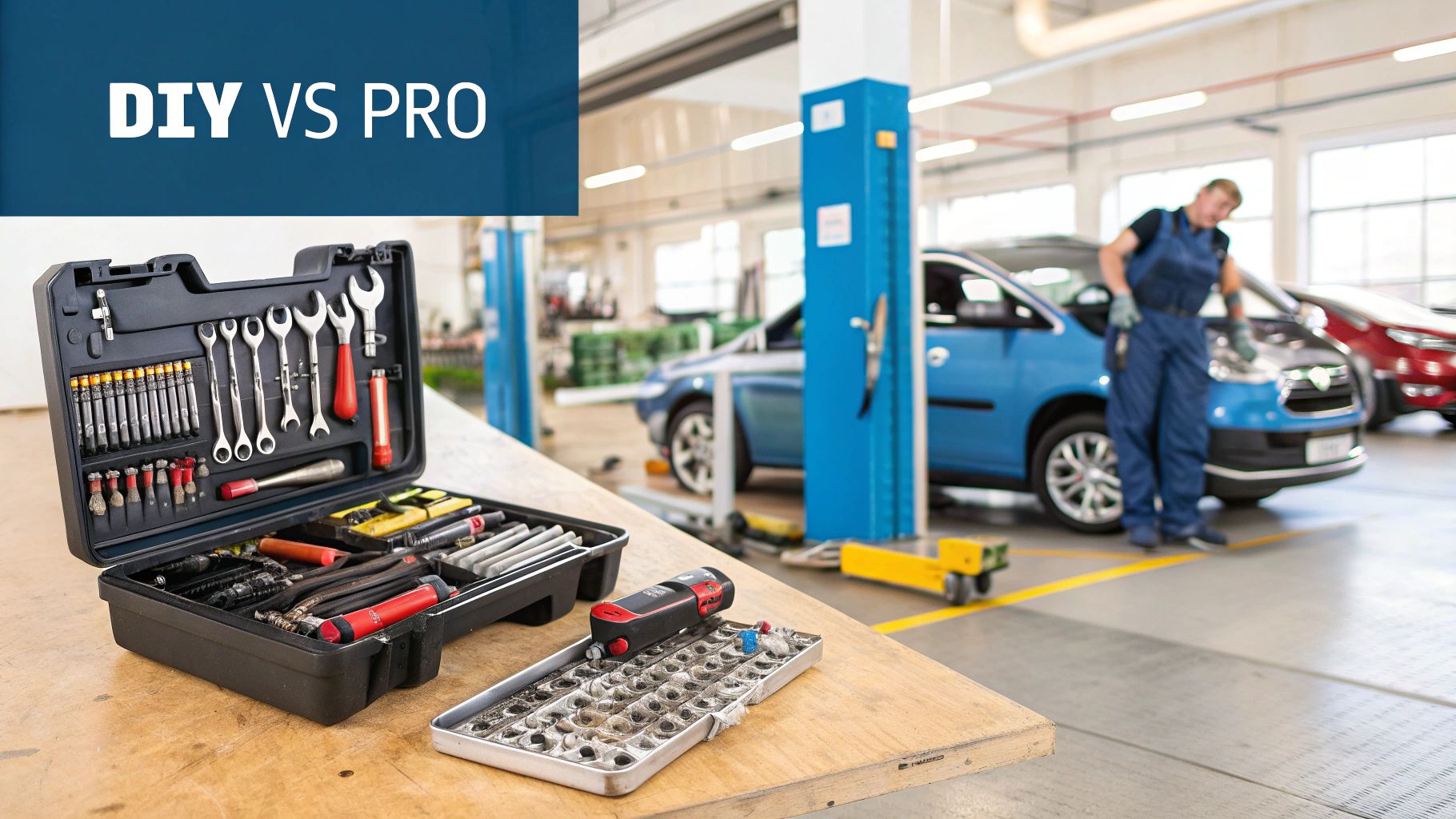
Knowing that electric vehicle maintenance is cheaper is one thing but actively trimming those costs down is where you’ll really feel the financial benefits. With a few smart habits and a little consistency, you can minimise what you spend and truly get the most out of driving electric.
These tips aren’t complicated or time-consuming. They’re practical adjustments to your routine that can make a real difference to your annual budget. From simple vehicle care to making smarter choices about servicing, every little bit helps lower the total cost of ownership.
Adopting Smart Servicing and Driving Habits
The easiest way to save money is simply to follow the manufacturer’s recommended service schedule. Sticking to the plan keeps your EV in top condition and, crucially, protects its warranty, saving you from potentially massive bills if something unexpected goes wrong.
Once your vehicle is out of warranty, you’ve got more freedom. It’s well worth looking for a reputable, certified independent garage that specialises in EVs. Their labour rates are often much lower than main dealers, yet they can deliver the same quality of work for a fraction of the price.
Don't underestimate the impact of your driving style, either. Smooth acceleration and gentle braking don’t just make for a calmer journey; they also dramatically extend the life of your tyres and brake components.
By making the most of regenerative braking and avoiding aggressive manoeuvres, you are actively preserving two of the most common wear-and-tear items on any vehicle. This simple change in habit directly translates into less frequent replacements and more money in your pocket.
Using smart technology can also be a great way to stay ahead of problems. Explore how GPS car trackers with vehicle health features can help monitor your EV's condition and give you valuable insights into its performance, helping you catch minor issues before they become expensive repairs.
Turning Your EV into a Revenue Stream
Beyond just saving money, innovative solutions now make it possible for EV owners to generate an income. One of the most exciting opportunities lies in operating a mobile charging unit, which transforms a vehicle from a cost into a potential business asset. This service is a game-changer for drivers stranded with a flat battery far from a fixed charging point.
An operator of a mobile charger can make substantial money by offering this convenient, on-demand service. By setting your own rates, you can provide an essential lifeline at the roadside, at events, or even at workplaces, creating a flexible and profitable business. For instance, charging a premium call-out fee plus a per-kWh rate could easily generate hundreds of pounds from just a few jobs, turning downtime into a significant revenue stream.
This model is at the forefront of the new 'Energy as a Service' economy. You can learn more about it and see how the revolutionary approach to recharging electric vehicles offers new opportunities to businesses and individual entrepreneurs. It's a strategy that empowers you not just to save money on your EV but to actively earn from it.
Still Have Questions About EV Maintenance Costs?
It's natural to have a few lingering questions when thinking about switching to an electric vehicle. To clear up any remaining doubts, here are some straight answers to the most common queries we hear.
How Long Does An EV Battery Really Last?
This is probably the biggest concern for new buyers but the reality is quite reassuring. EV batteries are built to last the entire life of the car and nearly all manufacturers back this up with a warranty of at least 8 years or 100,000 miles .
Battery health does decline over time but it’s a very slow, gradual process. A complete, unexpected failure needing a full replacement is incredibly rare during a typical ownership period. If you do find yourself needing a new battery outside the warranty, the costs can be high but they are coming down all the time as the technology gets better. More often than not, it's just a single module that needs swapping out, which is a far cheaper and simpler fix.
Do I Have to Use a Specialist Mechanic?
While your trusted local garage might not be fully kitted out for EVs just yet, the landscape is changing fast. A growing network of independent specialists are now fully qualified to handle electric vehicle servicing. For the first few years, it often makes sense to stick with a main dealer to protect your warranty.
Once that period is over, a certified EV technician at an independent garage can take care of everything you need, usually at a much friendlier price point than the main dealer.
Are EV Tyres More Expensive?
You might find that EV-specific tyres cost a little more upfront. They're specially constructed to handle the extra weight and instant torque of an electric car while keeping road noise to a minimum. However, the price gap is shrinking.
The real factor here isn't the purchase price but how quickly they wear. It's true that aggressive driving will chew through them faster than in a petrol car but if you drive smoothly, you can expect them to last just as long.
The most compelling financial argument for going electric is the total cost of ownership (TCO). This goes beyond the initial price and considers the entire range of expenses, including fuel and expected maintenance.
Can I Actually Make Money From My EV?
Yes, absolutely. One of the most exciting new opportunities is in mobile charging, a field with massive potential for entrepreneurs. By operating your own mobile charging unit, you can offer a vital, on-demand service to other EV drivers.
How much you can earn really depends on local demand and your pricing, but it's a genuine way to generate income from your investment. This is especially true in areas with few fixed charging points, where drivers will happily pay for the convenience of a top-up brought right to them. You can set your own rates and offer your services at events, for business fleets, or as a roadside assistance solution.
At ZAPME , we believe in empowering EV owners with flexible and effective charging solutions. Discover our mobile charging units and learn how you can become part of the future of on-demand energy.

